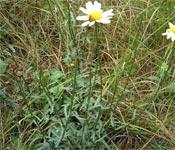Other Names – White daisy
Family – Sunflower Asterceae
Life Cycle – creeping perennial
Habitat – forage crops, hay fields, rangeland, wetland, roadsides
Key Features
- Short, creeping roots
- Spoon-shaped, coarsely-toothed basal leaves
- Strong, unpleasant odor
Seedling
Cotyledons are oval and stalkless. The first true leaves are broadly oval in shape with wavy, lobed margins.
Juvenile
Oxeye daisy has shallow, short, creeping roots. A basal rosette is produced in the first year. The rosette leaves are petioled, spoon-shaped and coarsely-toothed. They are dark-green and have a smooth, almost shiny surface. Tall, sparsely-branched stems emerge in the second year from a thick crown. They are typically smooth, but may be sparingly hairy at the base. The upper stem leaves are narrower and more deeply-toothed than the basal leaves. They are sessile and often clasp the stem. All parts of the plant have a stong, unpleasant odor.
Mature
Numerous yellow disk and white ray flowers occur in dense, showy, daisy-like heads. The oxeye daisy heads resemble those of scentless chamomile. The two weeds are easily distinguished by the spoon-shaped leaves and strong odor associated with oxeye daisy. Each of the tiny disk flowers in the center of the head produces a single seed. The seeds are narrow and black with ten prominent white ribs. They have a small projection on one end, but lack the feathery pappus typical of many other Asteraceae weeds.
 |
 |
 |
